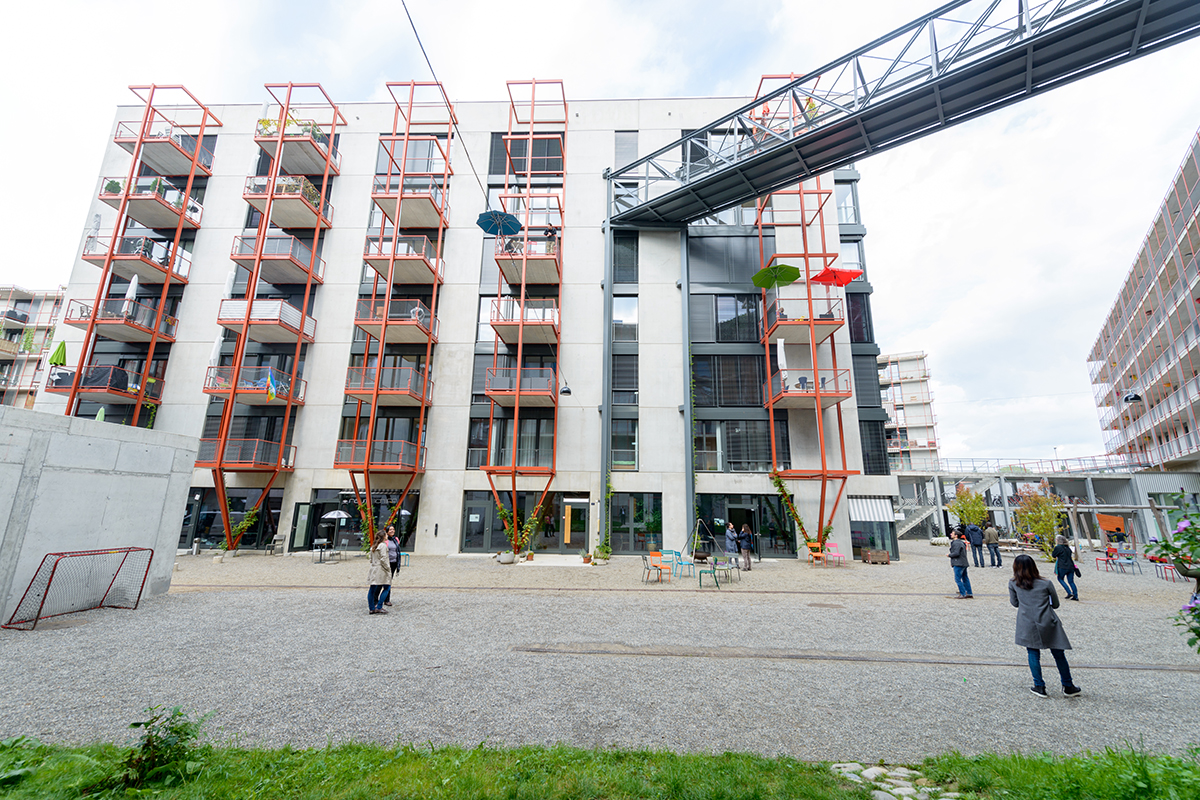You are viewing 1 of your 1 free articles
Rent to Buy or Rent to Rent?
The first snapshot of the success of Rent to Buy casts doubt on its effectiveness. Pete Apps asks if the scheme’s revitalisation is set to result in Greek tragedy. Illustration by Sam Hadley
As a punishment for angering Zeus, King Sisyphus was condemned to push a boulder up a mountain for all eternity.
Every time he came close to the top it would slip back, crush him and roll to the bottom – leaving him doomed to an unending cycle of wasted effort and frustration.
It is a plight with which many first-time buyers will empathise.
The latest attempt to overcome it – if some of the briefings circling in the national media are accurate – is a revitalisation of Rent to Buy. The Times last month reported briefings that the communities secretary is pushing for £100bn in next week’s Budget to fund 500,000 of these homes over the next decade.
It is a solution which is attractively neat.
Prospective buyers are offered a five-year tenancy at a discounted rent. They use this period to save up the cash necessary for a deposit. At the end of the tenancy, they have raised this cash and can purchase the home and live happily ever after.
But like most neat solutions, it is not as simple as it seems.
Inside Housing has gathered data on the last batch of Rent to Buy homes to provide the first ever snapshot of their success.
Like most neat solutions, it is not as simple as it seems
The numbers are worrying. They suggest for all but a handful of tenants, the journey to home-ownership remains as Sisyphean as it ever was – a five-year struggle to not quite reach the summit, followed by crushing disappointment.
Earlier this year, we sent Freedom of Information Act requests to the Homes and Communities Agency (HCA) and the Greater London Authority (GLA) seeking data on the Rent to Buy homes built under the National Affordable Housing Programme 2008/11.
These are significant because they are now more than five years on from completion – and therefore in theory through the cycle of renting and saving and at the stage when they have been purchased outright.
The HCA was able to confirm that 5,544 were completed by 2012 under the Rent to HomeBuy scheme. For the GLA there were 3,254 completions under an ‘intermediate rent’ product, which also assumed tenants would save and buy.
A snapshot of Rent to Buy completions
| Organisation name | Rent to Buy homes completed since 2008 | Number sold | % sold | Notes |
| BPHA | 619 | 102 | 16.48 | 29 subject to contract |
| Octavia | 39 | 14 | 35.9 | |
| Longhurst | 58 | 8 | 13.79 | 28 sold as shared ownership after previous tenants left |
| Thirteen | 124 | 18 | 14.52 | |
| Genesis | 148 | 10 | 6.76 | |
| Great Places | 208 | 0 | 0 | |
| Orbit | 85 | 23 | 27.06 | 40 ended tenancy with product sold to new buyer. Seven still rolling |
| Riverside | 248 | 0 | 0 | Sold 13 but not to original tenants |
| EMH | 65 | 5 | 7.69 | |
| Totals | 1,594 | 180 | 11.29 |
But neither organisation was able to release data on how many tenants had successfully gone on to buy. Simply, they have not been recording it.
The only option, therefore, was to go to each provider that received the funding and ask for the data on how many of the homes had been sold. Inside Housing requested numbers from the 30 largest developers of Rent to Buy homes under the programmes. In the end, only nine were able to confirm figures.
Some cited mergers and changes of structure as reasons for not being able to check. Others simply did not respond.
The nine organisations completed a total of 1,594 Rent to Buy units since 2008.
And of these, just 180 had successfully been sold to the tenants who hoped to buy them – a hit rate of only 11.3% (see table). For the rest, the tenants either moved out at the end of the tenancy or renewed for a further five years of renting.
So what went wrong?
The general consensus is fairly simple: they couldn’t afford it. A development director at one of the housing associations explains: “The problem was because of the lack of housing, the people being nominated to these schemes couldn’t afford to save up and buy. They were effectively being used as five-year lets for people who needed social housing.”
A spokesperson for north London-based Genesis, which sold 10 of 148 homes, adds: “We would attribute low uptake in some cases to areas seeing increase in value, meaning that some residents decide that they can no longer afford to buy.”
“You need to make sure you get the right tenants on the right plan.”
Longhurst Group, which operates mainly in the Midlands, sold eight homes of 58 developed to the original tenants. A further 28 were sold as shared ownership to other tenants after the original occupiers moved out.
A spokesperson points out that in some properties, tenants were refunded the first year’s rent to act as a deposit. This helped, but where it wasn’t available, take-up was limited.
“The relatively low number of Rent to Buy sales appears to be down to changes in circumstance for the customers that took this option. We saw a better return in areas where the first year’s rent was refunded as a contribution towards a deposit on the property. Where this option wasn’t available, it was much more challenging for people to find the deposit they needed,” the spokesperson says.
For Riverside, based in Merseyside but operating nationally, 248 Rent to Buy units have been completed since 2008. None of them have been sold to the original tenants, with 13 properties sold to other buyers.
To understand Riverside’s experience, though, the economic context must be explained. The homes were originally being developed as shared ownership properties, but were caught in the midst of the financial crisis. As prices dropped, the housing association decided to convert them to Rent to Buy, rather than sell them at a loss – something which still limits sales.
“Tenants living in these properties on assured shorthold tenancy agreements may purchase their home on shared ownership terms if they meet the criteria, and if the property value at the time has risen above our costs of providing it,” a spokesperson says. “In some areas the market is still recovering and we hope to be able to sell more of these homes as originally planned.”
Helen Collins, a director at Savills Housing Consultancy, speaks positively about the concept of Rent to Buy generally. “Rent to Buy removes the uncertainty that can sometimes be associated with market renting, and allows the option to purchase rather than necessarily making this an obligation,” she says.
But she notes that soaring property prices in high-value areas can scupper these plans. “Where Savills finds the most challenges with Rent to Buy tends to be in higher-value markets, where the barriers to accruing a sufficient deposit in particular are difficult to overcome without large subsidies being provided,” she says.
Rent to Buy is being rolled out more widely. In London, the GLA announced last year that its grant-funded London Living Rent will consist of homes for Rent to Buy – with rents based on a third of local average incomes for fixed-term tenancies of five years.
Up to 58,500 of these homes could be built through this programme by 2021 – although a substantial proportion of these will be shared ownership. The decision to make these homes Rent to Buy is understood to have been a concession to the homeownership-focused government of David Cameron – with whom Sadiq Khan negotiated the programme.
A substantial proportion of the HCA’s programme through to 2021 was also intended as Rent to Buy, although it is not clear how many of these are still planned given the changes to the programme brought about by Theresa May’s government.
“The problem with the previous schemes is that the allocation criteria was wrong,” Steve Collins, Rentplus
Finding a way to make Rent to Buy work is therefore a crucial task for social landlords and policymakers. One man who thinks he has the answer is Steve Collins, chief executive of Rentplus – a relatively young private company which aims to build 5,000 Rent to Buy homes across the South of England by 2020.
“The problem with the previous schemes is that the allocation criteria was wrong,” he says. “You had people going in who had an aspiration to buy after five years but were not necessarily able to afford it.”
Rentplus offers tenancies of five, 10, 15 and 20 years based on a detailed assessment of tenants’ plans to save. It is able to flex between these tenures if circumstances change – something which is more difficult to do if you’ve modelled a simple sale-at-year-five plan.
“This is a way to give people an opportunity to buy in a place they wouldn’t be able to afford to live without it,” he says. “But you need to have a proper allocation process and make sure you get the right tenants on the right plan.”
So far Mr Collins is three years into his first five-year cycle, with 95 homes under occupation. If his company can make Rent to Buy work, then policymakers should take note.
Writing in 1942, the philosopher Albert Camus asked us to reconsider the strife of Sisyphus. “The struggle itself… is enough to fill a man’s heart,” he wrote. “One must imagine Sisyphus happy.” Housing policy should not make the same mistake.
Reaction on Twitter
Similar or worse rate to shared ownership staircasing to 100%. Not a surprise. t.co/f0llFItbds
— Nearly Legal (@nearlylegal)Similar or worse rate to shared ownership staircasing to 100%. Not a surprise. https://t.co/f0llFItbds
— Nearly Legal (@nearlylegal) November 17, 2017
HAs across the sector bringing forward rent to buy, singly with @HCA_UK backing or in partnership with other providers & with varying models. E.g. #LondonLivingRent with shared ownership purchase.
— Tetlow King Planning (@Tetlow_King)HAs across the sector bringing forward rent to buy, singly with @HCA_UK backing or in partnership with other providers & with varying models. E.g. #LondonLivingRent with shared ownership purchase.
— Tetlow King Planning (@Tetlow_King) November 17, 2017
Rent to buy - 90% get to buy! Good research from @insidehousing Revealing that Govt dont record this Policy by gimmick t.co/GclIgFqNu9 #ukhousing #socialhousing
— Paul Kershaw (@1917paul)Rent to buy - 90% get to buy! Good research from @insidehousing Revealing that Govt dont record this Policy by gimmick https://t.co/GclIgFqNu9 #ukhousing #socialhousing
— Paul Kershaw (@1917paul) November 17, 2017
Inside Housing Spotlight
Inside Housing Spotlight is a series of pieces showcasing the best of our investigative and data journalism.
Spotlight pieces:
14 December 2018: Starting to bite - how Universal Credit is making people homeless: we reveal new figures showing a clear link between Universal Credit and homelessness
9 November 2018: First Priority - the inside story of a housing association which almost went bust When a small supported housing provider entered into a series of leasing deals with investment funds, it nearly spelled disaster for its vulnerable tenants. We investigate why.
12 October 2018: The ballad of Knowsley Housing Trust the inside story of the first housing association made non-compliant by the sector's watchdog for fire safety issues
13 September 2018: How tweaked building guidance led to combustible insulation on high rises: an investigation shows how lobbyists from the plastic insulation industry supported a quiet tweak to building guidance to permit combustible insulation on tall buildings
31 August 2018: The true cost of homelessness Freedom of Information requests reveal the soaring costs of temporary accommodation
30 August 2018: The forgotten threat to high rise tenants We investigate the threat posed by combustible window panels on social housing high rises
13 June 2018: The Biggest Ever Survey of Fire Risk Assessments Data journalism revealing widespread fire safety issues in more than 1,500 tower blocks across the country
12 April 2018: A Section 106 Story An investigation into allegations of "sham transactions" involving Section 106 deals in south London
23 March 2018: The Paper Trail: The Failure of Building Regulations A lengthy investigation into the failures of building regulation that may have contributed to the Grenfell Tower disaster, and the many missed warnings
23 February 2018: The Kingspan Papers Leaked meeting notes reveal some worrying issues, including allegations of fire safety report doctoring by manufacturers
9 February 2018: Gentoo: a Sunderland story We look back at the recent history of Sunderland’s largest housing association.
25 January 2018: Homeless families face long stays in council-owned hostels we reveal how councils in London are skirting the law by using hostels to house people in temporary accommodation for more than six weeks
7 December 2017: Council house to private rent We reveal the percentage of former Right to Buy homes in the private rented sector has passed 40%
17 November 2017: Rent to buy, or rent to rent? A look at how successful the government's Rent to Buy schemes have been
7 September 2017: Once upon a time in the west The history of KCTMO in the years before the Grenfell Tower fire
11 August: 2017 Grenfell: The paper trail - our news editor Pete Apps examines seven years of council documents to tell a story of the missed opportunites to prevent the Grenfell tragedy
4 August 2017 : Knowing the risks – the most common fire safety problems in tower blocks
26 May 2017: Rents hiked for RTB replacements – Sophie Barnes reveals less than half of Right to Buy replacement homes are for social rent
12 May 2017: A stark warning – a prescient piece looking at lessons to be learned from the Shepherds Bush tower block fire
13 April 2017: Where the axe will fall – a look at plans to axe housing benefit for younger people
10 Feb 2017: Circle of Despair – the inside story of Circle's repairs and maintenance troubles
3 Feb 2017: The Benefit Cap Tightrope – Sophie Barnes unveils the first exclusive analysis of the lower benefit cap














